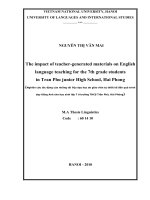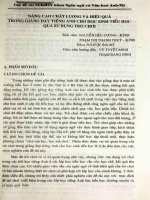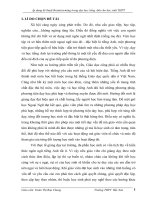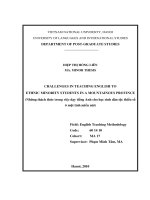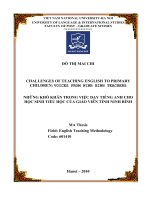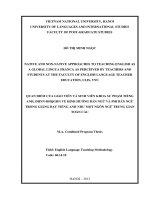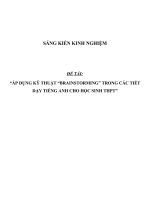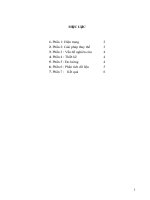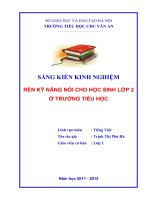Sự hài hước trong tập truyện cười Stories for Reproduction của L.A Hill và khả năng sử dụng tập truyện vào giảng dạy Tiếng Anh cho học sinh trường Trung cấp Thu
Bạn đang xem bản rút gọn của tài liệu. Xem và tải ngay bản đầy đủ của tài liệu tại đây (428.97 KB, 48 trang )
VIETNAM NATIONAL UNIVERSITY, HANOI
UNIVERSITY OF LANGUAGES AND INTERNATIONAL STUDIES
FACULTY OF POST-GRADUATE STUDIES
*********************
ĐẶNG NGỌC LY
HUMOR IN L.A. HILL’S STORIES FOR REPRODUCTION AND
THEIR POSSIBLE USES FOR TEACHING ENGLISH TO STUDENTS
AT THANH HÓA FISHERIES VOCATIONAL SCHOOL
Sự hài hước trong tập truyện cười Stories for Reproduction của L.A. Hill
và khả năng sử dụng tập truyện vào giảng dạy Tiếng Anh cho học sinh
trường Trung cấp Thuỷ sản Thanh Hoá
M.A MINOR PROGRAMME THESIS
FIELD: ENGLISH TEACHING METHODOLOGY
CODE: 60140111
Hanoi, 2014
VIETNAM NATIONAL UNIVERSITY, HANOI
UNIVERSITY OF LANGUAGES AND INTERNATIONAL STUDIES
FACULTY OF POST-GRADUATE STUDIES
*********************
ĐẶNG NGỌC LY
HUMOR IN L.A. HILL’S STORIES FOR REPRODUCTION AND
THEIR POSSIBLE USES FOR TEACHING ENGLISH TO STUDENTS
AT THANH HÓA FISHERIES VOCATIONAL SCHOOL
Sự hài hước trong tập truyện cười Stories for Reproduction của L.A. Hill
và khả năng sử dụng tập truyện vào giảng dạy Tiếng Anh cho học sinh
trường Trung cấp Thuỷ sản Thanh Hoá
M.A MINOR PROGRAMME THESIS
FIELD: ENGLISH TEACHING METHODOLOGY
CODE: 60140111
SUPERVISOR: Assoc. Prof. Dr. LÂM QUANG ĐÔNG
Hanoi, 2014
i
DECLARATION
I hereby declare that this is my own research work conducted on the sources
listed in the References part of the study.
Thanh Hóa, August 2014
Signature
Đặng Ngọc Ly
ii
ACKNOWLEDGEMENTS
First of all, I would particularly like to express my thanks to my supervisor
Assoc. Prof. Dr. Lâm Quang Đông for his support, guidance and valuable critical
feedback. For the completion of this thesis, the author has benefited a lot from his
courses, teachings, discussions and insights.
I would like to send my special thanks to the staff of the Faculty of Post-
graduate Studies of VNU University of Languages and International Studies for
their concern and useful lectures.
Last but not least, I want to express my deepest gratitude to my family for
their love, care, tolerance and encouragement.
iii
ABSTRACT
This study is an attempt to uncover ways of humor creation in the collection
Elementary Stories for Reproduction by L.A. Hill from both of linguistic and socio-
cultural perspectives. It provides learners of English with better understanding of
English jokes and funny stories. To complete this research, the theoretical
background of the factors creating humor is worked out for the interpretations. The
findings from the analysis have revealed the typical features that cause laughter in
the collection. Finally, the study suggests some interesting activities designed for
English language teaching and learning with the aim to use jokes as a useful
material to motivate students. Therefore, learners of English can understand and
make full use of funny stories to make English learning less challenging.
iv
ABBREVIATIONS
SLL
second language learning
L2
second language
SLA
second language acquisition
NNSs
Non-native speakers
NSs
native speakers
No.
number
LIST OF TABLE
Table 1: Proportions of factors creating humor in the collection
v
TABLE OF CONTENTS
DECLARATION i
ACKNOWLEDGEMENTS ii
ABSTRACT iii
ABBREVIATIONS ivi
LIST OF TABLE iv
PART A: INTRODUCTION 1
1. Rationale 1
2. Purposes of the study 2
3. Research questions 2
4. Scope of the study 2
5. Significance of the study 2
6. Methodology 2
6.1. Research method 2
6.2. Subject of study 3
6.3. Procedure 3
7. Structure of the thesis 3
PART B: DEVELOPMENT 4
CHAPTER I: LITERATURE REVIEW 4
1.1. Theoretical background 4
1.1.1. Humor 4
1.1.2. Pun 5
1.1.3. Ambiguity 5
1.1.4. Lexical ambiguity 6
1.1.5. Grammatical/structural ambiguity 8
1.1.6. Pragmatic ambiguity 9
1.1.7. Stupidity/ foolishness 12
1.2. Roles of humor in teaching English as a foreign language 12
1.3. Previous studies on similar theme 13
vi
1.4. Summary 14
CHAPTER II: MAJOR FACTORS WHICH CREATE HUMOR IN STORIES FOR
REPRODUCTION 15
2.1. Violation of socio-cultural norms 16
2.2. Violation of conversational maxims 18
2.3. Foolishness 19
2.4. Pun 20
2.5. Presuppositions 21
2.6. Homonymy 22
2.7. Polysemy 24
2.8. Chapter summary 24
CHAPTER III: POSSIBLE USES OF L.A. HILL‟S STORIES FOR
REPRODUCTION 25
3.1. Teaching vocabulary 25
3.2. Raising cultural-awareness 27
3.3. Teaching speaking skill 29
3.4. Teaching writing skill 32
3.5. Other communicative activities 34
3.6. Chapter summary 36
PART C: CONCLUSION 37
1. Recapitulation 37
2. Pedagogic implications for teacher 38
3. Limitation and Suggestion for further research 38
REFERENCES 39
1
PART A: INTRODUCTION
This part gives rationale, purposes, the research questions and methods, the
scope of the study and the structure of the thesis.
1. Rationale
The value of humor is extremely obvious in everyday life. Humor can lessen
stress, increase productivity and manifest satisfaction with life. However, is humor
valued in the classroom? Discussing this question, I would like to refer to this
quote, “Humor will not necessarily cause learning, but there is empirical evidence
to support the idea that humor creates conditions conducive to learning” (Ferguson
& Campinha-Bacote, 1989; Hill, 1988; Schwarz, 1989; Warnock,1989; Walter,
1990). Many researchers and teachers believe humor can be a valued tool in the
classroom. For instance, Jill P. Viers, in her writing Using Humor as a Teaching
Tool (2008) pointed out that “humor can reduce stress and anxiety, create a
comfortable learning environment, and increase motivation, comprehension, and
retention of information” while motivation is widely recognized as one of the most
important factors affecting second language acquisition. From my own experience, I
can confirm that humor can increase attention, motivation, excitement, and
interactions among students and between teacher and students therefore it can bring
class together.
In order to bring humor to the language classroom for the above recognized
benefits, I have tried to find different materials that can be used for my students.
Among those, the collection of jokes Stories for Reproduction of L.A Hill is a
highly valuable document that can be a really efficient tool during my teaching
process. The collection consists of 30 elementary short jokes with exercises which
are very suitable to my students‟ level and can be exploited in different ways as
complimentary to the core coursebooks to help them develop their English.
For the above reasons, I decide to conduct this study so as to identify the
features that create humor in Stories for Reproduction by L.A. Hill (Elementary
level, series 1) and how I can use them most effectively in my teaching English to
the students at Thanh Hóa Fisheries Vocational School.
2
2. Purposes of the study
As previously indicated, the study is set out to achieve the following
objectives:
- To find out typical features that constitute humor in the collection Stories for
Reproduction by L.A. Hill;
- To identify possible activities based on these short jokes so as to motivate
students in their English acquisition.
3. Research questions
1. What are the typical features that create humor in the collection Stories for
Reproduction by L.A. Hill?
2. What activities could be designed based on the collection for the first year
students of Thanh Hóa Fisheries Vocational School?
4. Scope of the study
This study only attempts to analyze the factors creating humor in the
collection Stories for Reproduction at elementary level, series 1 and it‟s possible
uses in the process of teaching English as a foreign language to the students of
Thanh Hóa Fisheries Vocational School.
5. Significance of the study
This study is conducted in the belief that my own and my students‟
knowledge of the English language and culture, particularly humor through the
medium of English, can be enhanced, which definitely benefits both teachers and
students alike. Furthermore, activities that can be designed using the collection can
serve as a useful source of reference and a valuable tool for English teaching and
learning not only at my own institution but many others as well. Using these
activities in class will make English learning fun, enjoyable, full of laughter and
ultimately easier and more effective.
6. Methodology
6.1. Research method
The study will be conducted as follows:
3
i) Enumerating the features that create humor in the collection. Within the
constraints of this study, and given the English course for particular students at
my institution, I will focus just on the collection the Elementary, series 1.
ii) Classifying the jokes into categories in terms of humor features; then describe
and analyze them. This will provide answer to the first research question.
iii) Finally, possible activities will be suggested for the use of the collection in
teaching English to the students. In this way, answers to the 2
nd
research
question will be presented.
The major method employed in this study therefore is a qualitative one.
6.2. Subject of study
Stories for Reproduction by L.A. Hill, Elementary, series .
6.3. Procedure
- Firstly, data, including relevant theories and the jokes for analysis will be
collected. Relevant theories will be extracted from various linguistic books and
some related topics from the Internet and previous MA thesis.
- Secondly, 30 jokes will be analyzed to work out humor features; each joke will be
analyzed in terms of those features.
- Thirdly, based on the results of the analysis, suggested activities for improving
students‟ English through these jokes can be proposed.
7. Structure of the thesis
The thesis is composed of three main parts and references.
Part A, INTRODUCTION, presents the rationale, the purposes, research
questions, significance, scope, methodology as well as the structure of the thesis.
Part B is DEVELOPMENT which consists of three chapters.
Chapter One: Literature Review
Chapter Two: Major factors which create humor in Stories for Reproduction
Chapter Three: Possible uses of L.A. Hill’s Stories for Reproduction
Part C is CONCLUSION. In this part, a review of the study is presented,
together with implications for teaching and learning, limitation of the study and
suggestions for further studies.
The thesis is ended with REFERENCES.
4
PART B: DEVELOPMENT
CHAPTER I: LITERATURE REVIEW
In this chapter, the literature related to humor, general factors creating humor
in English jokes and previous studies are discussed in order to provide the study
with the sufficient theory background.
1.1. Theoretical background
1.1.1. Humor
“Laughter is the best medicine” is a saying which is popular with almost all of
us. Most of us would always come across people who are fond of jokes. It can be
claimed that all of us do like humor and would prefer humorous friends, and even
humorous life-partners. In everyday life, the individual human being suffers from a
lot of stress and tensions. School-going children are increasingly being burdened
with exams and competition, college-goers are to look for jobs, bread-earners have
to be concerned about their families, and housewives have to care for all the
domestic issues in their house. Everyone is caught up in this vicious circle of life.
There, at times, seems to be no way out of all these. Even though we may try to
bring about a sense of real-life humor, circumstances do not permit it (Avanija
Katiyar , 2011). People of all ages and cultures are able to experience humor.
Humor is considered as a form of entertainment and a form of human
communication with its aim to make people laugh and feel relaxed. Humor is also
considered as a part of culture, ability or quality of a person, enrich the language of
a person. A sense of humor is variable depending on age, sex, geographical
location, culture, maturity, level of education and context.
It is not disclaimed that humor is an important factor of teaching and learning.
Justifications for the use of humor include the promotion of understanding,
attracting the attention of students, creating a positive attitude to the subject matter,
and reducing anxiety. Empirical studies of the connections between humor and
learning are reviewed. These indicate that humor, in case it is used harmoniously,
can increase attention and interest and help to illustrate and reinforce what is being
taught. It is suggested that the presentation of humorous material involves skills
which can be learnt through practice and that staff development programs should
5
provide opportunities for academics to acquire such skills (J. P. Powell & L. W.
Andresen, 1985).
1.1.2. Pun
The English meaning of pun, which comes from the Italian word puntiglio
meaning “fine point” is the humorous use of a word in such a way as to suggest two
or more of its meanings or the meaning of another word similar in sound so the pun
is a form of humor involving linguistic ambiguity. Humorous effects created by
puns depend upon the ambiguities words entail. The ambiguities arise mostly in
homophones and homonyms. For instance, in a sentence A happy life depends on a
liver, liver can refer to the organ liver or simply the person who lives. Similarly, in a
famous saying Atheism is a non-prophet institution the word prophet is used instead
of profit to produce a humorous effect.
Pun is a form of word play which suggests two or more meanings, by
exploiting multiple meanings of words, or of similar-sounding words, for an
intended humorous or rhetorical effect.
1.1.3. Ambiguity
According to Zhang Qing-liang in A Discussion on Ambiguity in English
(2007), ambiguity is defined as the fact that a word (or an expression) or a sentence,
before realization of stress, stop, intonation or other phonological means and
without any more presuppositions or contexts than what the word or the sentence
itself creates, can be regarded as two or more different descriptive senses.
That is why a single expression may lead to multiple interpretations. In natural
language many words, strings of words and sentences are ambiguous, simply
because of the fact that numerous words cover several distinct meanings, or specific
structural elements give rise to different readings. That means that “an expression or
utterance is ambiguous if it can be interpreted in more than one way” (Löbner,
2002: 39).
It often happens that when we are talking, we may not realize there is any
ambiguity there but when we have it written down and isolate every sentence from
the context, we will find that many of the sentences are ambiguous; and the more
parts we divide the whole into, the more ambiguity we have.
6
1.1.4. Lexical ambiguity
Lexical ambiguity is ambiguity based on a single word. In many cases, a
single word in a language corresponds to more than one thought, for example, the
adjective light (not dark vs. not heavy); the noun bank (financial institution vs. the
edge of a river); and the verb run (to move fast vs. to direct or manage). Words may
also have more than one meaning through their unrelated use in more than one
category of speech, for example, can (a container of food – noun vs. to be able to –
verb). Inattentive use of ambiguous words can lead to humorous or even awkward
situations. Lexical ambiguity is ambiguity attributable to the fact that some
ambiguous words contained in the sentence causes the whole sentence to be
ambiguous. There are two type of lexical ambiguity: homonymy and polysemy.
1.1.4.1. Homonymy
Knowing a word means knowing both its sounds and its meaning. Both are
crucial in determining whether words are the same or different. If words differ in
pronunciation but have the same meaning, such as sofa and couch, they are different
words. Likewise, words with identical pronunciation but significantly different
meanings, such as tale and tail, are also different words. Spelling is not relevant,
only pronunciation. Thus, bat the animal and bat for hitting baseballs are different
words because they have different meanings although they are pronounced
identically.
Words like tale and tail are homonyms. Homonyms are different words that
are pronounced the same, but may or may not be spelled the same. To, too, and two
are homonyms despite their spelling differences.
Homonyms can create ambiguity. A word or a sentence is ambiguous if it
can be understood or interpreted on more than one way. The sentence I’ll meet you
by the bank may mean “I’ll meet you by the financial institution” or “I’ll meet you
by the riverside”. Homonymy is one of most important sources of popular humor as
well as confusion:
“Waiter !”
“Yes, sir.”
“What is this ?”
7
“It’s bean soup, sir.”
“Never mind what it has been. I want to know what it is now”
Bean, noun and been, past participle of to be are homonyms. They are in the
same sound but different spelling.
Homonyms are words which are identical in sound and spelling, or, at least,
in one of these aspects, but different in their meaning.
Homonymy can be further divided into three types:
- Homographs are words that are spelled the same, but have different
meanings, such as dove the bird, and dove, the past tense of dive.
- Homophones are words that are identical in sound but differ in spelling and
meaning are called homophones, e.g. air-heir, see-sea.
- Full homonyms are words that are identical in sound and spelling are called
full homonyms, e.g. match, n. - a game, a contest and match, n. - a short piece of
wood used for producing fire.
Homonyms are good candidates for humor, as well as for confusion, e.g.
“How is bread made ?”
“I know that” Alice cried eagerly. “You take some flour.”
“Where do you pick the flower?” The White Queen asked, “in the garden or
in the hedges?”
“Well, it isn’t picked at all.” Alice explained. “It’s ground.”
“How many acres of ground?” said the White Queen.
The humor of this passage is based on two sets of homonyms : flower and
flour and two meanings of ground. Case of homonymy seems very few in a
language system and very definitely to be matters of mere accident of coincidence.
1.1.4.2. Polysemy
Polysemy is a property of a single word. Polysemy is characteristic of most
words in English. E.g. I run home vs. I run this office.
A case of polysemy is one where a word has several clearly related senses,
e.g. mouth (of a river vs. of an animal), the two senses are clearly related by the
concept of an opening from the interior of some solid mass to the outside, and of a
place of issue at the end of some long narrow channel. Chimney (pipe of a tunnel-
8
like structure on a building for smoke to escape through vs. narrow vertical space
rocks up which a climber can wriggle by pressing against the sides), both senses
contain the concept of a narrow vertical shaft in some solid material. Cases of
polysemy are numerous in a language system. In the dictionary, the great majority
of lexical items are polysemous.
Homonymy and polysemy are closely related and often treated together
because on face value, what we see is various meanings are associated with the
same forms. They are distinguished from each other in terms of semantic
relatedness. If different meanings associated with one form are perceived as related,
they constitute a polysemantic word; if these meanings are not related in any way,
they are treated as homonyms. However, in practice it is difficult to draw a clear
line between homonymy and polysemy. The difference between a polysemy and
a homonym is difficult to determine.
1.1.5. Grammatical/structural ambiguity
Structural ambiguity is ambiguity does not lie in the words but rests on two
or more possibilities of relationship of modification among words contained in the
sentence.
Structural ambiguity occurs when a phrase or sentence has more than one
underlying structure, such as the phrases Tibetan history teacher, a student of high
moral principles and short men and women, and the sentences The girl hit the boy
with a book and Visiting relatives can be boring. These ambiguities are said to be
structural because each such phrase can be represented in two structurally different
ways, e.g., [Tibetan history] teacher and Tibetan [history teacher]. Indeed, the
existence of such ambiguities provides strong evidence for a level of underlying
syntactic structure . Consider the structurally ambiguous sentence, The chicken is
ready to eat, which could be used to describe either a hungry chicken or a broiled
chicken. It is arguable that the operative reading depends on whether or not the
implicit subject of the infinitive clause to eat is tied anaphorically to the subject the
chicken of the main clause.
It is not always clear when we have a case of structural ambiguity. Consider,
for example, the elliptical sentence, Perot knows a richer man than Trump. It has
9
two meanings, that Perot knows a man who is richer than Trump and that Perot
knows man who is richer than any man Trump knows, and is therefore ambiguous.
But what about the sentence John loves his mother and so does Bill? It can be used
to say either that John loves John's mother and Bill loves Bill's mother or that John
loves John's mother and Bill loves John's mother. But is it really ambiguous? One
might argue that the clause so does Bill is unambiguous and may be read
unequivocally as saying in the context that Bill does the same thing that John does,
and although there are two different possibilities for what counts as doing the same
thing, these alternatives are not fixed semantically. Hence the ambiguity is merely
apparent and better described as semantic under determination.
1.1.6. Pragmatic ambiguity
Another type of ambiguity explored in jokes has its roots in pragmatic rule
that govern discourse (Grice 1975). In this type of ambiguity, the minimal
ambiguous string is longer than in any of the above types of linguistic ambiguity.
The two readings result from non- or misapplication of Grice‟s cooperative
principle of conversation or any of the Gricean maxims (Grice 1975; Pepicello
1987; Yamaguchi 1988; Attardo 1990). As an illustration, consider joke :
Two farmers had known each other all their lives, but their conversations
were usually restricted to “Good morning” or “Nice day”. One afternoon,
however, the first farmer asked:
“Hi, Pete, what did you give your horse when he had the colic?”
“Turpentine,” said Pete.
“Thanks”, said his friend.
Two weeks later they met again.
“Didn’t you tell me, Pete, that you gave your horse turpentine when he had
the colic?”
“Yes,” said Pete.
“Well, I gave mine turpentine and he died.”
“So did mine,” said Pete. (Misztal 1991:506)
Jokes are regarded to involve pragmatic ambiguity when they produce two
readings different in pragmatic function while the sentence structure, lexical items
10
and phonetic strings in both readings are identical. To be more specific, the
funniness of these jokes are created on the basis of a surprise aroused when the
intention and the result of the event conflict. That is to say between the two
speakers, there exists a misunderstanding or communication breakdown in
interpreting the exact pragmatic transaction or the intentional use of language.
1.1.6.1. Violation of socio-cultural norms
Norms are the agreed-upon expectations and rules by which a culture guides
the behavior of its members in any given situation. Of course, norms vary widely
across cultural groups. Americans, for instance, maintain fairly direct eye contact
when conversing with others. Asians, on the other hand, may avert their eyes as a
sign of politeness and respect
Sociologists speak of at least four types of norms: folkways, mores, taboos,
and laws. Folkways, sometimes known as “conventions” or “customs,” are
standards of behavior that are socially approved but not morally significant. For
example, belching loudly after eating dinner at someone else's home breaks an
American folkway. Mores are norms of morality. Breaking mores, like attending
church in the nude, will offend most people of a culture. Certain behaviors are
considered taboo, meaning a culture absolutely forbids them, like incest in U.S.
culture. Finally, laws are a formal body of rules enacted by the state and backed by
the power of the state. Virtually all taboos, like child abuse, are enacted into law,
although not all mores are. For example, wearing a bikini to church may be
offensive, but it is not against the law.
Members of a culture must conform to its norms for the culture to exist and
function. Hence, members must want to conform and obey rules. They first must
internalize the social norms and values that dictate what is “normal” for the culture;
then they must socialize, or teach norms and values to, their children. If
internalization and socialization fail to produce conformity, some form of “social
control” is eventually needed. Social control may take the form of ostracism, fines,
punishments, and even imprisonment.
Socio-cultural norms are rules that a group or society uses to determine what
is appropriate and inappropriate in behavior, expression, and values. If one does not
11
follow the rules, one can suffer consequences such as exclusion from the group. The
norms can change over time and according to the particular members of the group.
1.1.6.2. Violation of conversational maxims
Here are a summary of the four conversational maxims:
- Maxim of quantity: is concerned with the amount of information (taken in its
broadest sense) an utterance conveys.
Make your contribution as informative as is required (for the current
purposes of the conversation)
Do not make your contribution more informative than is required
- Maxim of relation: be relevant
The point of this maxim is that is not sufficient for a statement to be true for it to
constitute an acceptable conversational contribution.
- Maxim of quality: is concerned with truth-telling, and has two parts:
Do not say what you believe to be false
Do not say that for which you lack adequate evidence
- Maxim of manner: has four components:
Avoid obscurity of expression
Avoid unnecessary ambiguity
Be brief (avoid unnecessary prolixity)
Be orderly
(Grice, 1975 : 45)
When only one of the maxims above is violated, misunderstanding can happen.
1.1.6.3. Presupposition
In everyday sense of presuppose, to presuppose something is to assume
something, or to take it for granted in advance, but not to say it. Since assuming
something is not normally considered an act but rather a state, presupposing is best
viewed as a state and not an act. Related to (pragmatic) presupposing is (pragmatic)
presupposition : that which is assumed or taken for granted. Clearly,
presuppositions are not acts, though they are related to them. This characterization
is pretty vague, but the phenomena cited in current linguistics under the label of
12
(pragmatic) presupposition are quite varied, and our characterization has at least
virtue of reflecting a common denominator among many different kinds of cases.
1.1.7. Stupidity/ foolishness
This is one more way to create humor in funny stories. Foolishness expresses
in one‟s actions, the most typical sample of this is an extremely famous film
character Mr Bean acted by British actor Rowan Atkinson, or one‟s sayings which
are very common in jokes in many languages. Foolishness may originates from
unequal knowledge levels, various cultures, dialect, misunderstanding or even
cognition.
1.2. Roles of humor in teaching English as a foreign language
In the past few years researchers have begun to show an interest in humor and
language play as it relates to second language learning (SLL). Tarone (2000) has
suggested that second language (L2) play may be facilitative of SLL, in particular
by developing sociolinguistic competence, as learners experiment with L2 voices;
and by destabilizing the interlanguage system, thus allowing growth to continue.
She recommends research examining the ways in which adult L2 speakers
interacting outside the classroom play with language as a way of learning more
about this issue. Using case study methodology to document the ways in which L2
verbal humor was negotiated and constructed by three advanced non-native
speakers (NNSs) of English as they interacted with native speakers (NSs) of
English, this study contributes to this knowledge base by showing patterns of
interaction that arise during humorous language play between NSs and NNSs and
how these may benefit second language acquisition (SLA). Results suggest that
language play can be a marker of proficiency, as more advanced participants used
L2 linguistic resources in more creative ways. Language play may also result in
deeper processing of lexical items, making them more memorable, thus it may be
especially helpful in the acquisition of vocabulary and semantic fields.
It is my contention that humor is one important type of sign vehicle that the
teacher may use to correct or supplement information about themselves that was
communicated in earlier behavior. Because teachers are so significant a part of a
classroom situated activity system, their humorous expressions of self may also be
13
viewed as strategies that affect the tenor of evens in the immediate present of that
system.
Practically speaking, teachers who wish to use humor as a strategy to facilitate
instruction or maintain order should have a rudimentary understanding of the
sociological processes connected with it. For humor, when inappropriately use, it
may become a double-edged knife and may worsen relations with students.
The joke is potential for a humorous situation. The joke can reduce students‟
boredom and allow students to interact with others naturally and may create good
competition among them. The element of surprise from joke frequently makes the
class atmosphere more pleasant, increasing interaction among students and teacher,
making learning more meaningful and enjoyable, a useful tool to get students‟
attention.
A joke is a device that creates linguistic awareness in the classroom. The
different activities presented here are just some of the procedures to be explored in
order to show students that learning a foreign language is actually fun. Humor
transforms the ambience of the class when students enjoy sharing their playful
strategies with others. When everyone benefits, the acquisition of a foreign
language becomes “easy”, and learners become motivated and creative.
1.3. Previous studies on similar theme
Regarding the linguistic theories of humor and ambiguity, several previous
studies have been conducted in the linguistic study (Zhang Qing-lang, 2007; Robert
Lew , 1996 ; María Teresa Sanschez Roura , 1995). These theorists mainly focus on
how the humor is achieved by the use of language, especially by ambiguity.
In A discussion on Ambiguity in English (2007), Zhang Qing-lang attempted
to study the definition and classification of ambiguity, the factors underlying
ambiguity according to the research goal, method and criterion. Lexical ambiguity
is associated with polysemy and homonymy, syntactic ambiguity is the result of
different grouping of elements, and semantic ambiguity results from the different
logical relationships between elements.
Robert Lew at Adam Mickiewicz University, Poznan, in Exploitation of
Linguistic Ambiguity in Polish and English Jokes (1996), claimed that : Whether
14
jokes based on pragmatic ambiguity should be treated on a par with syntactic,
lexical and phonological ambiguity is debatable. If translatability is to be taken as a
valid test for linguistic jokes, then jokes exploring pragmatic ambiguity should be
excluded. On the other hand, there are many instances of jokes based on syntactic
ambiguity which are translatable, though obviously not as universally as pragmatic
jokes. If the distinction between linguistic and non-linguistic jokes is to be upheld, it
is best kept so as to exclude pragmatic jokes.
Beside, María Teresa Sanschez Roura (1995) in Syntactic Ambiguity as a
Device in British Humour asserted that the ambiguity at the syntactic level in the
English language focuses on its resourceful applications in the creation of jokes.
Such ambiguity is therefore regarded as something to be exploited in language
rather than avoided. One important conclusion will be that British humor should be
regarded as “strange” by speakers of other languages, who can only access to it by
means of poor, or should we say, difficult translations, since not all types of
ambiguity are translatable across languages. The study is divided into three sections,
dealing firstly with bracketing of constituents and labelling of categories and
functions; and secondly, focusing on transformational relationships, whereby two
underlying structures are related to one surface structure. The illustrations are real
jokes collected from a variety of popular jokes books.
1.4. Summary
These previous studies provide general background knowledge to deal with
the research questions. The examples above prove that humor is a very attractive
and complicated problem. And due to the roles of humor in everyday life, there is
reason in applying it in class to teach English as a foreign language, specifically
using 30 jokes in Stories for Reproduction by L.A. Hills to teach English to the
students at Thanh Hóa Fisheries Vocational School.
15
CHAPTER II: MAJOR FACTORS WHICH CREATE HUMOR IN STORIES
FOR REPRODUCTION
Basing on the theoretical background presented in the previous chapter, we
can classify the 30 jokes of the collection into seven groups of factors which create
humor. The first group contains various forms of violation of socio-cultural norms,
which accounts for 40 percent; 20 percent is the proportion of violations of
conversational maxims; approximate 3 percent is proportion of presupposition. The
second group is foolishness which accounts for 17 percent. 10 percent is proportion
of pun. The last group of lexical ambiguity including two linguistic phenomena
homonymy and polysemy account for approximate 3 percent for each.
Table 1 below clearly illustrates these figures.
Factors creating humor
Stories numbered
Proportion
Lexical ambiguity
Homonymy
20
~3%
Polysemy
8
~3%
Pragmatic
ambiguity
Violation of
conversational
maxims
6, 9, 10, 22, 24, 25
20%
Violation of socio-
cultural norms
1, 3, 11, 12, 14,
15, 16, 17, 18, 23,
26, 27, 30
43%
Presuppositions
13
~3%
Stupidity/Foolishness
5, 19, 21, 28, 29
~17%
Puns
2, 4, 7
10%
Table 1: Proportions of factors creating humor in the collection
16
More detailed analyses of each of these factors are presented hereafter.
2.1. Violation of socio-cultural norms
Socio-cultural norms, in a way, are some kind of „standards‟ or stereotypical
expectations imposed by a certain society or cultural group on its individual
members. They are unwritten rules that guide behaviors, or are accepted behaviors
in any given society; they include values, attitudes and beliefs, etc. Violations of
those norms may result in an individual being funny, ridiculous, even outcasted to
the community. Therefore, violations of socio-cultural norms lend themselves to
very high use in creating humor, as evident in the 43% of Hill‟s Stories for
Reproduction in Table 1.
Different kinds of socio-cultural norms have been used in these stories, the
first of which is gender stereotypes. For instance, women are expected to be careful,
meticulous, considerate; they are supposed to be good at cooking, have fine tastes in
clothing, etc. So the following story is a good lesson to a wife:
Elizabeth always cooked the dinner when she and her husband, Tom, got
home, and when they had meat, Tom always cut it up when they sat down to eat.
One evening, while Tom was cutting the meat up, Elizabeth said to him, “When we
were first married, Tom, you always gave me the bigger piece of meat when you cut
it, and you kept the smaller one for yourself. Now you do the opposite : you gave me
the smaller piece of meat and keep the bigger one for yourself. Why do you do that?
Don’t you love me anymore?” Tom laughed and answered, “Oh, no, Elizabeth. It
isn’t that! It’s because you’ve learned to cook now!”
On the contrary, men are generally believed not to know much about
cooking. They seem to be endowed with the privilege of being fed by their wives,
so whenever wives are away, husbands will be in big trouble, as the following story
shows:
One morning, Mrs. Petty, before going out, said to her husband, “I’ll leave
you some food for your lunch. Is that all right?”
“Oh, yes” her husband answered, “That’s quite all right. What are you
going to leave for my lunch?”
“This tin of fish,” Mrs. Petty said.
17
“Good,” Mr. Petty answered, “I’ll have a good lunch.”
At three o’clock Mrs. Petty came home.
“Was your fish nice, Jack?” she asked.
“Yes, but my feet are hurting,” he answered.
“Why are they hurting?” Mrs. Petty asked.
“Well, the words on the tin were, “Open tin and stand in hot water for five
minutes”.
Second come socio-cultural norms on behaviors and interpersonal relations.
Story No. 1 can help illustrate this point:
Jack was a young sailor. He was often away with his ship. After a long
voyage, he came back and fell in love with his new neighbor, Gloria. One day, he
sent her a wonderful parrot from a port in Africa which could speak five languages.
However, when Jack’s ship reached Australia, he received a letter from Gloria. It
said, “Thank you for your parrot, Jack. It tasted much better than a chicken”.
Young lovers normally present each other various gifts on numerous
occasions, which, more often than not, are symbolic of their love rather than the
gifts‟ actual use value. To almost everyone, parrots are known as nice pets for their
ability to imitate human voices and their beauty, amongst others. Jack wanted to
give Gloria this talking parrot as something very special to keep her company as if
he were always with her. Yet, it can be inferred that this girl Gloria may have little
appreciation of beauty or very strong desire for exotic food, so the poor bird found
itself vanish in her stomach. Definitely, Gloria‟s failure to understand the
significance of Jack‟s act of sending her the parrot would seriously damage, or even
destroy their relation.
Sometimes individuals do not violate socio-cultural norms; instead, they
keep them, act upon them, but their application of the norms is inappropriate, or
they leave it to others to observe the norms, not themselves, as seen in this story. It
is about 7-year-old boy, Dick, and his 5-year-old sister, Catherine.
One day, their aunt took Dick into the kitchen, gave him a nice cake and a
knife then said to him, “Cut the cake in half and give one of the pieces to your
sister, but remember to do it like a gentleman.” “How do gentlemen do it?” asked
